How To Treat Fungus In Garden Soil
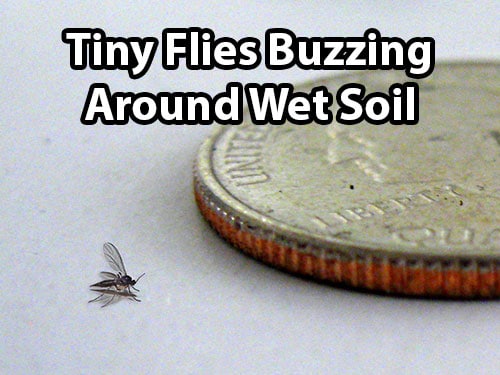
Cannabis Fungus Gnat Cheat Sheet
Fungus gnats look like tiny flies buzzing around cannabis plants, especially around the soil. Their larva grows in wet soil, and they often appear when the topsoil stays wet for too long between waterings.
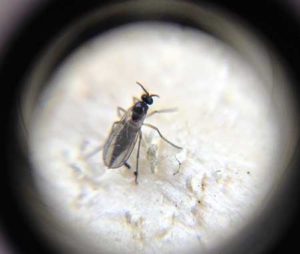
How to Get Rid of Fungus Gnats:
A fungus gnat is so small it's thinner than the width of a quarter. They commonly appear when cannabis plants are watered too often. If you let the top inch of your soil dry out before watering your plants each time, fungus gnats often naturally go away on their own. However, if you have a really bad infestation, it can take weeks of good watering practices before you get rid of all of them unless you also do something to directly kill the bugs and bring down their numbers. Read on to learn how to get rid of fungus gnats on your cannabis plants for good.
- Important! Let the topsoil dry out between waterings. Fungus gnats usually result from over-watering.
- Yellow Sticky Cards – cut down on their numbers
- A Fungus gnat-killing product – Either a wide spectrum insect killer or something with BT like crushed up mosquito bits mixed with water in a mister or used to water your plant.
- Diatomaceous earth – this white powder is harmless to people and animals but is sharp at a microscopic level and will kill gnats. Sprinkle it around the grow room and on your topsoil.
Table of Contents
Introduction
What Causes Fungus Gnats To Attack Your Cannabis Plants? Wet topsoil!
How Do You Know You Have Fungus Gnats?
- Pictures of Fungus Gnat Damage to Cannabis Leaves
How To Get Rid of Fungus Gnats in Your Soil
Prevention: Safeguard Your Next Grow
For Composters: Get Rid of Fungus Gnats In Your Compost Pile
Get the Stuff to Fight off a Fungus Gnat Invasion
by Nebula Haze
Introduction
Fungus gnats – how do you get rid of these tiny flying pests that lay eggs in your soil? This article will teach cannabis growers (like you) exactly that: how to completely eradicate fungus gnats and ensure they never come back!
Fungus gnats are a common problem for soil cannabis growers (especially those who overwater their plants!), but they're actually easy to get rid of once you know what to do!
Fungus gnats (also known as "sciarid flies") are black or dark brown flies which look liketiny mosquitoes with dark wings.
How Big Is a Fungus Gnat?
Fungus gnats are small, only about 2 mm long. To give you an idea of how big that is, 2mm is about the thickness of a quarter.
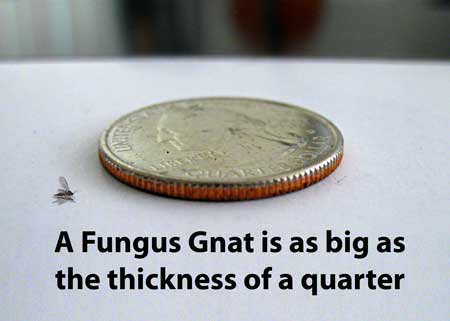
Despite their small size, fungus gnats can be a big nuisance in your soil cannabis grow, mostly because their tiny maggot/larvae offspring will hurt your plant's roots (which will cause problems for your plants).
What Causes Fungus Gnats to Attack Cannabis Plants?
Fungus gnat larvae eat fungus or decaying matter and need wet conditions to thrive. It is common for soil growers to overwater their cannabis plants, and wet soil is the perfect home for fungus and decaying organic matter. After fungus has grown (often invisible to the naked eye) or overwatered matter has begun to decay in the topsoil, fungus gnat lays their eggs in the top layer of wet soil.
Warm + wet topsoil = fungus gnats (and other problems or pests in soil)
These eggs hatch into larvae that look like tiny maggots which only live in the top 2-3 inches (5-8 cm) of soil. The fungus gnat larvae are the culprits which cause damage to cannabis roots.
Cannabis roots are not the main source of food for fungus gnat larvae, but roots get caught in the crossfire. Although the main diet of fungus gnats is fungus and decaying matter, the larvae happily gnaw on root hairs and young tender roots of cannabis plants.
![]()
The damage to the roots from these little suckers cause problems in the leaves and slowed growth. A bad fungus gnat infestation can even kill cannabis plants, especially young seedlings.
While the main problem is that fungus gnat larvae attack the roots of your cannabis plants, the adult fungus gnats can also spread diseases (such as pythium – a common cause of root rot) via their feet.
Because of these problems, it is important to get rid of a fungus gnat infestation right away.
If fungus gnats need fungus and decaying matter to survive, where is the fungus coming from? Fungus grows in wet conditions and is an essential part of the environment (where it breaks down organic matter like dead leaves). Fungus spores are around us everywhere pretty much all the time, but these spores will never start growing without moisture. Warm and wet conditions in the soil of a cannabis grow are what cause fungus to grow and matter to decay. Sometimes you won't even be able to see the fungus or decaying matter with the naked eye. But once the conditions are right, fungus gnats thrive in the top layer of your soil whether you can see fungus or not.
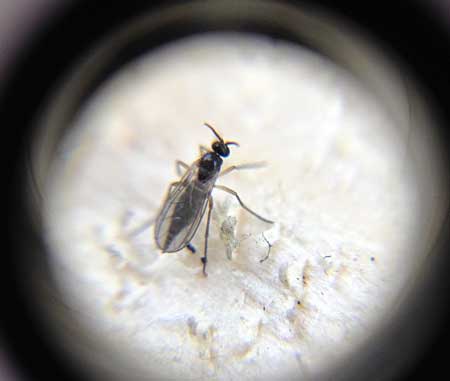
Check To Make Sure You Have Fungus Gnats
1.) Tiny flying black bugs around your plants & crawling on your soil
Even if your plant or leaves aren't showing symptoms or distress yet, if you see fungus gnats it means that you have a problem with fungus and moisture in your soil. Don't let the infestation get out of hand. It's always recommended to get rid of any pests in the grow room as soon as you know they're there!
This video shows you what fungus gnats look like, and also go over how to get rid of them (or just read the rest of the article!)
The adult fungus gnat flies are just annoying (and gross); they don't bite you and don't do much to hurt your plants directly besides spreading disease. But even though the mature fungus gnats aren't a huge threat to your plants, the presence of adult gnats lets you know that your cannabis soil has been infested with their maggot offspring which causes the real problems.
2.) Tiny white or translucent larvae with black heads in the soil
Note: this picture is really big so you can see what you're looking for, but the actual larvae/maggots are TINY. If you spot them, you'll just see tiny white spots wriggling around in the topsoil.
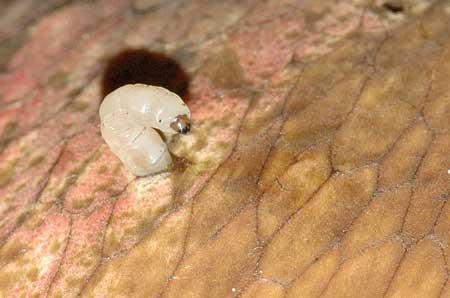
It's the fungus gnat larvae in the soil that damage your plant roots and cause growing problems, especially to seedlings or young plants.
How Fungus Gnat Larvae Cause Damage to Cannabis Plants
Larvae attack tender new plant roots and root hairs, which cause these problems:
- "Damping off" – seeds or seedlings are weak for no apparent reason; sometimes stems weaken and seedlings can even just fall over and die
- If the fungus gnat infestation gets out of hand, even adult cannabis plants start looking unhealthy, showing many symptoms such aswilting, yellowing, drooping, spots
- Cannabis leaves may show signs of nutrient deficiency (or deficiencies) which seem to be unrelated to pH, nutrients, or any other identifiable nutrient problem
- Plants will start growing slowly and may even stop growing altogether
- If the infestation hits in the flowering stage, yields can be reduced
Fungus Gnats vs Fruit Flies
Quick Check! Make sure you have fungus gnats and not fruit flies.
Fruit flies are brown/yellow/orange while fungus gnats are dark brown or black. Fruit flies tend to be bigger/fatter and easier to see than tiny fungus gnats. You need to take a slightly different approach with fruit flies.
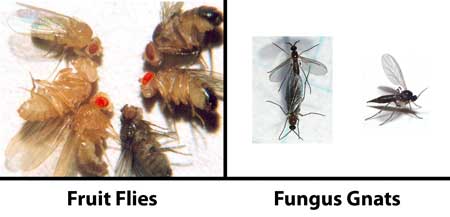
Thanks toIlona L. andRichard Leung for the closeup Fungus Gnat pics!
Fruit flies will keep coming back if there's ripe or rotting fruit to eat. If you've ever left a banana or other fruit on your counter too long, you've probably noticed how fruit flies seem to be able to appear out of thin air if there's ripe fruit around.
Fruit flies can start buzzing around poorly composted soil which contains kitchen scraps, but otherwise, fruit flies are uncommon in the grow room unless there's ripe/rotting fruit or other tasty bits for them to eat.
So once you get rid of their food, the fruit flies will disappear.
Pics of Damage to Cannabis Plants From Fungus Gnats
A fungus gnat infestation on your cannabis plants can cause all sorts of strange problems – often they look like overwatering, pH problems or nutrient deficiencies. The more fungus gnats you have, the more likely you'll see damaged leaves and reduced growth rates.
Since fungus gnats are almost always caused by overwatering and too-wet topsoil conditions, some of these symptoms may actually be caused by too-wet soil. In any case, when you see fungus gnats, it means there's a problem in your setup that needs to be addressed.
Here's some pictures of cannabis plants affected by a gnat infestation. Notice how the leaves don't look healthy (there's yellowing, spots, curling, etc). It's almost impossible to tell that you have fungus gnats just by looking at the leaves of the plant because it can cause all sorts of different symptoms.
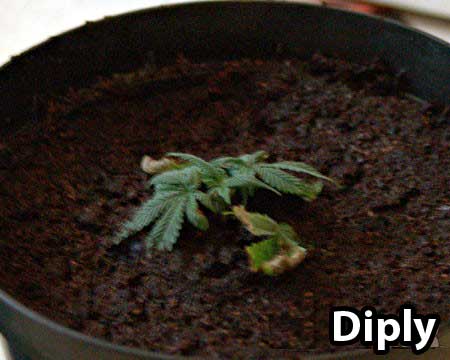
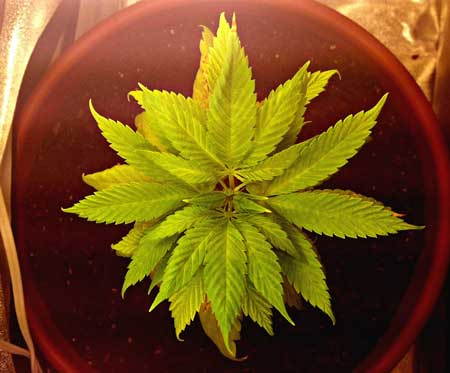
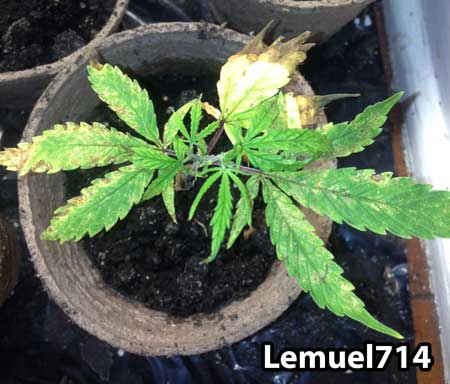
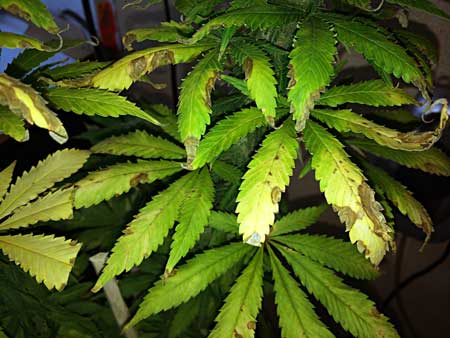
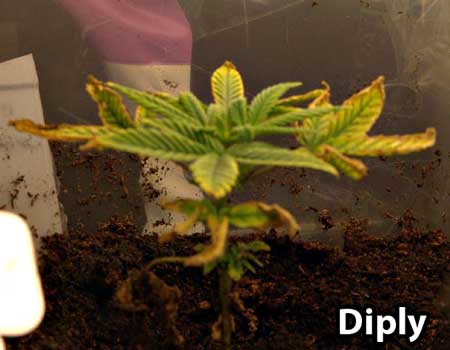
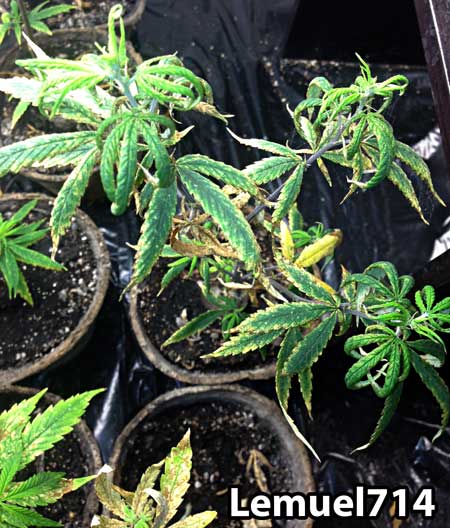
Here's a flowering cannabis plant affected by fungus gnats
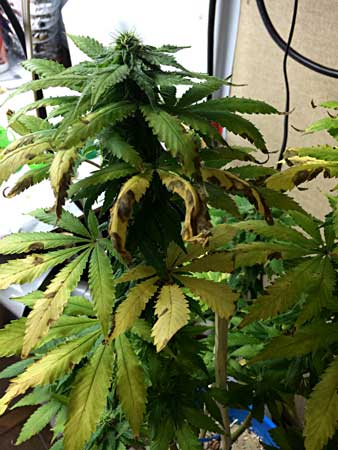
What To Do If You Have Fungus Gnats in Your Soil
Most importantly, don't overwater your plants! Never water cannabis plants grown in soil until the top inch of soil feels dry (up to your first knuckle). Fungus gnats need wet topsoil conditions to grow and thrive. The most common reason growers get fungus gnats is overwatering their plants.
Without Wet Topsoil, Fungus Gnats Naturally Disappear!
While the steps below will help you get rid of your fungus gnats quickly and effectively, the gnats will almost always go away on their own if you simply stop overwatering your cannabis plants. When there's no fungus, there's no fungus gnats, and both need wet conditions to grow. But if you already have them, here's hwo to kick them out of your grow area…
Get Rid Of Fungus Gnats Quickly: What You Need
- Yellow Sticky Cards
- A Fungus gnat-killing product – Either a wide spectrum insect killer or something with BT like crushed up mosquito bits mixed with water in a mister.
- Diatomaceous earth
- A fan to blow air over the top of your soil
1.) Place yellow sticky cards in the grow area – fungus gnats love the color yellow and will fly towards it. These yellow sticky cards (found at most gardening stores) are covered with a glue that will trap adult fungus gnats, bringing down their numbers.
But the most important reason to use yellow sticky cards is to help you keep track of how bad the current fungus gnat infestation is. As the infestation is reduced, there will be less adults caught in the yellow sticky traps. That's how you know that your approach is working.
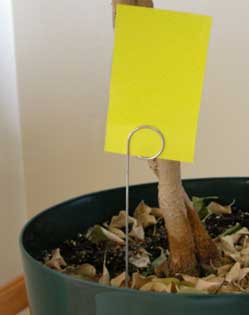
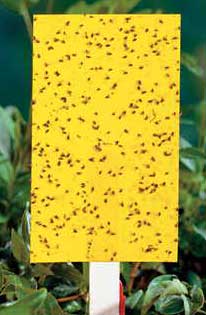
Get Yellow Sticky Cards on Amazon
2.) Get a fan blowing air over the top of the growing medium. This helps dry out the top layer of your soil, and also helps prevent the fungus gnats from being able to fly around and lay more eggs.
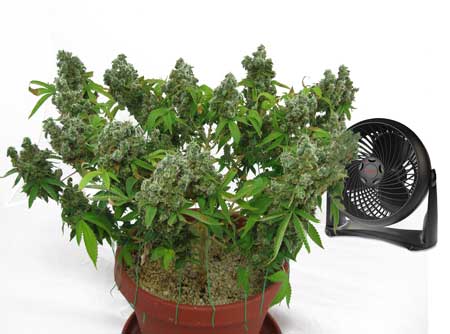

Get a Tabletop Fan on Amazon
3.) Don't water your plants for a few days. You want to begin drying out the soil to kill as many larvae as you can before you apply a treatment (which will involve watering). Fungus gnat larvae need a warm, wet environment near the surface of your soil to grow. Even after you've gone through all these steps and believe fungus gnats are gone, make sure to avoid overwatering plants, as this is the most common reason growers get fungus gnats in the first place. Don't do the next step until the top few inches of soil has dried out
4.) Kill the Larvae in The Soil
- Treat top layer of soil with wide spectrum insect killer (follow the directions).

- Use a powder duster to spread food-grade diatomaceous earth overexposed parts of soil.This will help kill the fungus gnat larvae and will also help prevent infestations in the future. While not completely necessary, adding diatomaceous earth is a great step to take to help get rid of the fungus gnats and their larvae as fast as possibleDiatomaceous earth is an organic insect killer made of fossilized shells. It is sharp on the microscopic level and works by puncturing the exoskeleton of insects (draining them of their body fluids), but poses no harm to humans or pets and can even be eaten.
Get Diatomaceous Earth On Amazon (this particular bag comes with a powder duster which makes it easier to apply)

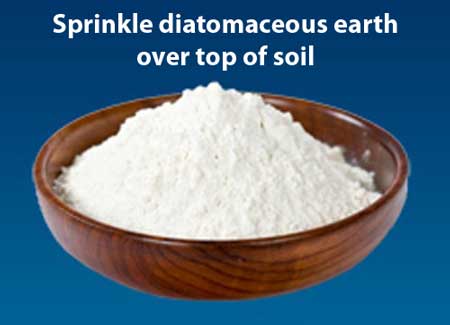
If you still have fungus gnats after doing that for a few days, try to mix it up because they will start getting resistant to your chosen treatment. Try one of these alternative cures:
- Essentria IC3 Insecticide is a mix of various horticultural oils that is organic and safe for humans. It is often marketed as a "bed bug killer" but is also very effective against fungus gnats when the plants are treated regularly. You want to apply this every other days or possibly combine with other options. You will need a mister (also called a "One-Hand Pressure Sprayer") to spray the soil evenly, and make sure to follow the directions! Like all the options, it's safe to use until a few days before harvest.

- BT Bacteria – Another thing you can water your plants with is something that contains "BT" bacteria (specifically, Bacillus thuringiensis varisraelensis– there is another type of BT that's meant for caterpillars), for example Mosquito Bits. However, they need to be crushed up into a powder so it will mix in the water for the best results when watering your plants. Just like any other time, always pH your water right before giving it to your plants!


- Hydrogen Peroxide (food grade if possible) – If you don't have access to any of the products, you can start getting creative at home. Usually, these types of remedies aren't as effective as the "real" stuff but they will definitely still kill a lot of bugs! Use 1 part hydrogen peroxide to 4 parts water (for 3% pure H2O2) – another type of brute force attack to kill larvae directly.

Learn about "good bugs" that kill Fungus Gnat larvae below
5.) Avoid overwatering your cannabis plants from now on. Never water your cannabis plants in soil until the top inch or two of soil has dried out. From now on, you don't want to ever let the top part of soil stay wet to create a breeding ground for fungus and fungus gnats. How often do I water my cannabis plants? Until the fungus gnats are gone, let your plant dry out a lot more than normal between waterings, and then you can go back to a normal watering schedule.
6.) Keep your sticky yellow cards up until Fungus Gnats are completely gone. These yellow sticky cards will continue killing adult gnats. They're also helpful because they will alert you to whether fungus gnat numbers are rising or falling. Even after killing all the larvae, it may take a few days to a few weeks before the adult fungus gnats are completely gone and you stop seeing new gnats caught on your sticky cards.
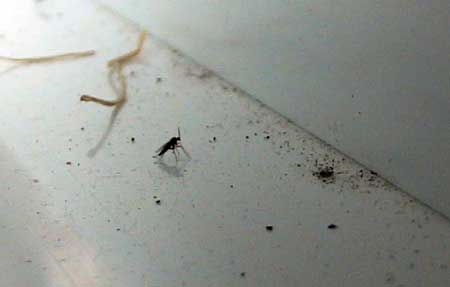
What is bacillus thuringiensis var israelensis?
This type of bacteria produces a toxin that hurts the larvae of fungus gnats and prevents them from being able to eat (it also kills mosquito larva), but doesn't affect your plants or roots. Products that contain this bacteria are sometimes listed as "BT" or "BTi" (to indicate the subspeciesisraelensis – which is particularly effective against fungus gnats). It is also safe for fish, pets, humans and pretty much everything besides larvae. It is safe for organic grows, even in the middle of the flowering/budding stage, and won't hurt other microbes living in the soil.
When using pellet-type formulations of bacillus thuringiensis, you will get better results if you crush it up before sprinkling on soil, or mix it with water. Always make sure to get Bacillus thuringiensis var israelensis(other types of BT are better at caterpillars). Powder and dry formulations ofbacillus thuringiensis seem to work better than liquid ones.
Other Ways to Kill Fungus Gnat Larvae
Whilebacillus thuringiensis is probably the best way to naturally kill fungus gnat larvae, you can use other biological control methods to kill these maggots. The following options will help control fungus gnat infestations but will likely not completely get rid of them unless you stop overwatering your plants.
- pathogenic nematodes (Steinernema feltiae)
- predatory mites (Hypoaspis miles) (Hypoaspis aculeifer)
Growing Organic? The "brute force" methods above like Hydrogen Peroxide will kill the fungus gnat larvae, but will also kill many beneficial microbes in the soil. You can add beneficial microbes back, but it will take a while for them to repopulate your soil. This problem only really affects organic soil growers. If you're providing nutrients to your plants with bottled nutrients, you're already providing nutrients in a way that your plants will be able to use even if the microbe populations are down. In any case, if growing organically, an organic version of bacillus thuringiensis (subspecies israelensis) is the best option for getting rid of fungus gnats.
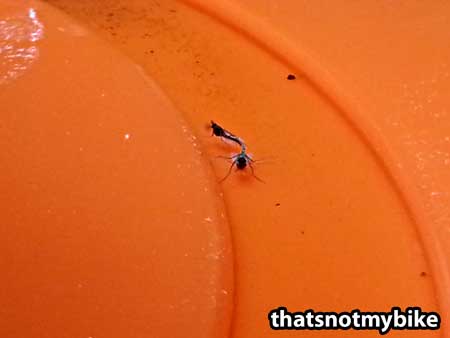
Prepare For Your Next Grow: Prevention
Before your next grow, make sure you thoroughly clean your growing area if you've been attacked by fungus gnats or other pests. Get rid of any houseplants that have any bugs flying around them. Never buy soil that has already been infested with fungus gnats or show any signs of flying bugs or larvae/maggots.
Some growers will even cook new soil to make sure any fungus gnat larvae are dead before letting their cannabis plants or clones near it.
If you're getting cannabis clones, make sure you get them from a trusted source and inspect closely for fungus gnats (as well as spider mites or other pests). You may want to start with seeds if you're growing in soil and worried about bugs, as clones are the most common way to introduce pests to the grow room.
Speaking of cannabis clones… I know this article is about fungus gnats, but I want to mention something else that's very important about cannabis clones. While fungus gnats are a big nuisance, they are not the worst pests a grower can get from cannabis clones. Fungus gnat problems pale in comparison to the horrible affliction of getting cannabis-specific spidermites (aka "the borg").
Once a grow room gets infected by the borg, it is incredibly difficult to get rid of these resilient pests which kill your plants, eat your leaves, and cover your plants (and buds) with horrible webbing. Always check new cannabis clones thoroughly (including under leaves for bugs or eggs) before letting new clones anywhere near your grow area! You may want to dip new clones in spider mite killer to make sure they are free of spider mites. Learn more about spider mites.
Some growers will start with cannabis seeds (as opposed to clones) to reduce the chance they ever have to deal with spider mites or fungus gnats!
What To Do with Fungus Gnats in Your Compost Pile
What do you do if fungus gnats attack your compost pile, where you are trying to build up beneficial microbe populations in the soil?
Here's a list of ways to control a fungus gnat infestation in your compost pile:
1.) Make Sure Compost Pile Isn't Too Wet
If you've got a fungus gnat problem, you should probably allow the compost to dry out somewhat. The most common reason for fungus gnats in a compost pile is wet conditions. Too-wet conditions also prevents proper composting, so this is something you need to address before you do anything else. Compost piles should be about as dry as a wrung-out sponge, and should not seem wet.
2.) Kill Larvae
Sprinkle food-grade Diatomaceous Earth over exposed parts of compost pile – this kills some of the gnats and larvae, but is completely harmless to humans. Diatomaceous Earth is very sharp on a micro level, and will pierce the outside of tiny bugs or larvae, killing them. Yet to macro creatures like dogs, cats and humans, Diatomaceous Earth is completely harmless and can even be eaten
If you have an extreme fungus gnat problem, use a Pest treatment with "bacillus thuringiensis" (subspecies "israelensis" is best), for example Mosquito Bits, Mosquito Dunks, etc. Sometimes known as "BT." Dry or powder formulations work best for fungus gnats. Break it up and sprinkle over top of compost, add water to "activate" the bacteria so it starts killing fungus gnat larvae.
After you've made sure the compost pile isn't too wet, cover pile with tarp or plastic sheeting. This helps disrupt the life cycle of fungus gnats.
You also might want to consider keeping your compost in a bin with a lid so bugs can't get in or out. In some places, this is actually a requirement due to local regulations.
3.) Compost Pile Maintenance
Generally, it's not recommended to add kitchen scraps to a compost pile for cannabis, since cannabis requires specific ratios of nutrients to provide the best growth which can't be achieved easily with kitchen scraps. However, if you are adding new kitchen waste to your compost pile, bury it in the middle of the pile so it's not on top for the fungus gnats (or fruit flies) to feed on. Learn about how to compost your own organic super soil (using this method, it's very unlikely you will be hit by fungus gnats or fruit flies).
Some growers will cover their compost pile with items that have a lot of carbon, such as cardboard, shredded paper, or brown leaves. This also disrupts the fungus gnat life cycle, but tarp or plastic sheeting is easier. If you've mixed your compost pile properly using a proven cannabis composting recipe, it is unlikely that you will need to add extra carbon to prevent fungus gnats.
Turn over the compost heap regularly if fungus gnats are a constant problem because compost pile is too wet – this helps mix everything well so compost dries out quickly, and also prevents pockets of fungus gnat larvae from taking hold
Well maintained compost piles typically become very hot during the composting process, so with all the steps above, and with no way for the larvae to escape through the plastic sheeting, the composting process should cook any remaining larvae and kill them.
Get the Stuff to Fight off a Fungus Gnat Invasion!

Yellow Sticky Cards – Kills adult fungus gnats and gives you a good idea of their current population.

Table Fan – They can't lay eggs if they can't fly or land!

Diatomaceous Earth – Kills larvae faster than I can correctly spell 'diatomaceous'!

Mosquito Bits – Once crushed and watered, they release a bacteria that doesn't like larvae. Totally safe for plants, though!
Jump to…
7-Step Remedy to 99% of Cannabis Growing Problems
Pictures of Marijuana Problems
How to Water Plants Perfectly Every Time
Overwatering Explained
How To Treat Fungus In Garden Soil
Source: https://www.growweedeasy.com/cannabis-plant-problems/fungus-gnats
Posted by: allenmignobt.blogspot.com



0 Response to "How To Treat Fungus In Garden Soil"
Post a Comment